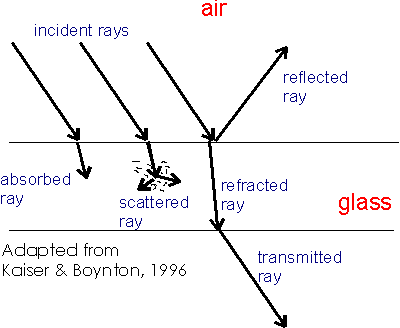 This diagram illustrates the different ways that light rays behave when going from one medium (e.g.. air) to another (e.g.. glass). These principles apply to spectacles, magnifying glasses, even such mundane things as window glass.
some light rays are absorbed when they enter glass. Other become scattered. Yet others are refracted. A close inspection of this diagram will reveal that when light goes from one medium to another its path changes. It does not continue in the same direction (i.e. the same angle) in glass as it did in air. this change of direction is called refraction. Refraction of light rays is the critical phenomenon that occurs when light first enters the eye or as it passes through your spectacle lenses.
This diagram illustrates the different ways that light rays behave when going from one medium (e.g.. air) to another (e.g.. glass). These principles apply to spectacles, magnifying glasses, even such mundane things as window glass.
some light rays are absorbed when they enter glass. Other become scattered. Yet others are refracted. A close inspection of this diagram will reveal that when light goes from one medium to another its path changes. It does not continue in the same direction (i.e. the same angle) in glass as it did in air. this change of direction is called refraction. Refraction of light rays is the critical phenomenon that occurs when light first enters the eye or as it passes through your spectacle lenses.All glass will reflect light to a certain extent. As a matter of fact spectacle wearers are sometimes bothered by such reflections and therefore have an anti reflection coating put on their glasses. Nevertheless, in clear glass most of the light is refracted as it enters and as it leaves the glass. The degree of refraction depends on the type of glass (actually it depends on the change of any medium that light enters, glass, plastic, water etc.). Another critical factor in how much the ray refracts is the angle at which light hits the medium it encounters. Hence the different curvatures in differently powered spectacles.
Some rays are reflected from the top surface of the glass, other rays from the second surface (not illustrated). Finally, some rays pass through and are called transmittedrays.